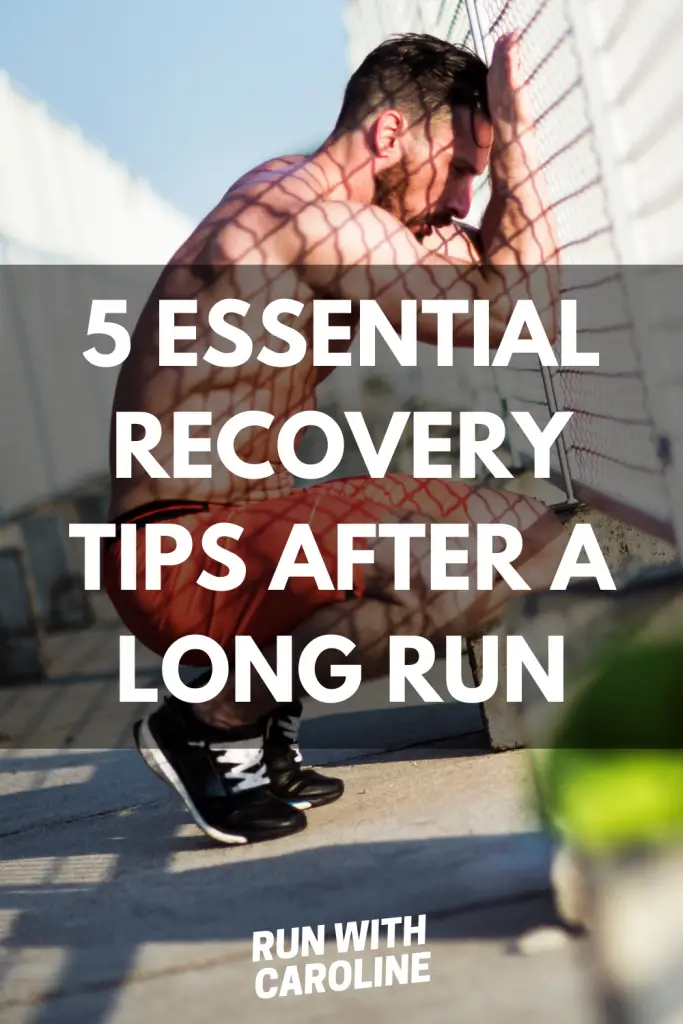Running can be hard on the body, especially after a long run.
However, there are recovery tips after a long run that you can adopt to optimise your recovery.
When you complete a long run, the temptation is to just sit at home and do nothing for the rest of the day.
There are lots of things that you could be doing to aid recovery and prevent some of those niggling running injuries. In this guide we’ll highlight some practical recovery tips after a long run.
In this guide we’ll explore:
- Why is recovery after a long run important?
- How long should you rest after a long run?
- What should runners do after a long run?
- 5 recovery tips after a long run

Why is recovery after a long run important?
Post-run recovery is important for any runner to help
In a 2018 study conducted on 46 recreational male runners, it was found that recovery methods can help to alleviate the effects of muscle fatigue caused by strenuous exercise.
Apart from nutritional strategies, the study found that three of the best known recovery interventions are active recovery (also known as a cool down), cold water immersion and massage.

Recovery after running: 5 recovery tips after a long run
Cool down
A proper cool down after a run is just as important as a warm up.
Over the years there has been some debate over the effectiveness of a cool down.
In my opinion it’s a simple and easy way to recover after a long run and there are simple tips you can apply immediately.
Whilst the warm up prepares your body and mind for the run ahead, a cool down eases your body back into reality.
The cool down lowers your heart rate and transitions your body back into its pre-exercise state.
It also prepares you in the best way possible for your next run.
If you stop abruptly after a run without a cool down, this encourages blood pooling and can cause dizziness.
Instead, walk briskly for 5-10 minutes after your run, then transition into a light jog and do this for 5-10 minutes more.
It’s also good to incorporate some cool down stretches. More on this below.
Stretch
Stretching is essential following your long run.
While the benefits of stretching is still debated in the running world, I still believe there are merits to stretching after a run.
Aim to hold each stretch for 20-30 seconds and focus on the main muscle groups (e.g. quads, hamstrings, calves, hips) as well as anything that is niggling or felt sore on the run.
If you have a foam roller, it’s also beneficial to roll your sore muscles on the foam roller to alleviate any knots or tightness.
Foam rolling is a great way to reduce muscle soreness and loosen tight muscles, but leave at least 24 hours before you foam roll.
If you foam roll too soon after your run, you risk tearing your muscles even more.
You could also consider a relaxing hot bath in the evening after your run.
Stick in some Epsom salts and soak in the hot water for a good 10-15 minutes.
This will help with the removal of excess toxins from your muscles.
Even better, the bath will help you sleep and ensure you are properly rested before your next run.
Yoga is also great for improving your flexibility as a runner.
The ‘legs up on the wall’ pose is great for refreshing circulation – allowing blood that has pooled in your legs to return to your heart.

Re-hydrate
Hydration is really important after your run, especially if your run was 90 minutes or longer.
This is probably one of the few tips that you can’t afford to miss when looking to aid your recovery after a long run.
The general rule of thumb is to consume 150% of the fluid that you lost during training within the first 10 to 15 minutes after stopping.
I know it’s hard to determine how much sweat you lost during your run, so drink until you quench your thirst then keep sipping on water throughout the day after your run.
Aside from normal tap water, electrolyte drinks like Powerade and Gatorade are a great way to help replace electrolytes lost during your run through sweat.
You’ve probably seen the salt stains on your clothes and tasted the salt in your sweat running down your face.
By drinking electrolyte drinks, you’re essentially replacing the salt lost through your sweat during your run.
Refuel
After a long run, you will have depleted the majority of your energy stores.
It’s really important to eat right following your run (within 20 minutes) to replenish your energy stores and repair any damage to muscle tissue.
The two key macronutrients for any runner are carbohydrates and protein.
Whilst carbohydrates are essential for maintaining and replenishing your energy levels, protein is essential for muscle repair.
You want to be mixing carbs with protein after a run to speed up the recovery process.
Aim for a 4 to 1 ratio of carbohydrates to protein.
Whey and soy protein are both good examples of protein that are rapidly digested by the body.
Protein shakes, for example, offer a good balance of high carbohydrates and high quality protein that you can consume in a convenient way.
Mix protein powder with your favourite smoothie ingredients.
Here are some good examples of post-run recovery smoothies for runners.
In terms of food, avoid anything that is high in fibre or fat, such as nuts or chocolate, as these can be slow to digest. Instead, prioritise carbohydrates and foods with high protein.
Some good examples include Greek yoghurt, bananas, peanut butter, eggs, kefir, quinoa, tuna and cottage cheese
Train smart
One of the most common mistakes runners make is running too soon after their long run.
If you have just completed a half marathon, for example, then you will want to take it easy.
I’ve written a blog post on how to recover after a half marathon so check this out too.
Your body has been through a lot. The best way to recover is not to do more damage by going out for a run the next day.
Invest in short, light effort, low impact cross training activities that boost circulation, warm up your muscles and aid in the recovery journey.
Cycling, swimming, walking and yoga are all good examples of cross training.
If you feel better after a few days, run a short, easy effort run (about 30 minutes) to test the waters before going back into another long run.
- 5 things I wish I’d known before returning to running - March 3, 2024
- Running 20 minutes a day: Benefits + how to start - January 27, 2024
- How to run your first 2 hour half marathon - January 16, 2024
